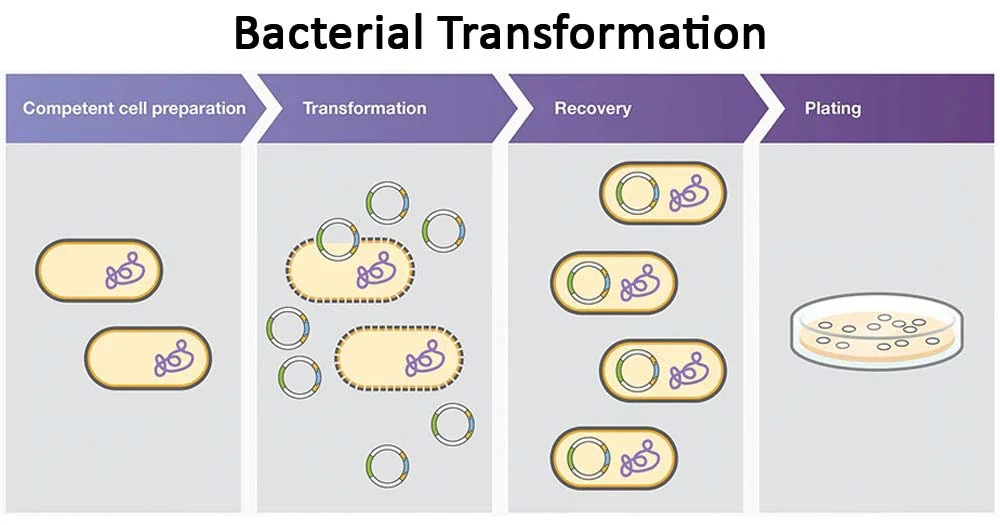Biomed Lab I FINAL
1/24
There's no tags or description
Looks like no tags are added yet.
Name | Mastery | Learn | Test | Matching | Spaced |
|---|
No study sessions yet.
25 Terms
Prokaryotes
organisms made up of cells without a nucleus or any membrane-encased organelles
ex: bacteria
Plasmid
small, circular extrachromosomal DNA found in bacteria
Genome
the complete set of genetic information of an organism
Chromosomes
long strands of DNA molecules that store an organism’s genome
Genes
short segments of DNA containing protein-coding information
located in chromosomal DNA
DNA
aka deoxyribonucleic acid
long chains composed of repeating subunits called nucleotides
Adenine, Tyrosine, Cytosine, Guanine
antiparallel strands
DNA 5’ … 3’
RNA 3’ … 5’
pGLO Plasmid
recombinant pGLO plasmid that contains several genes and DNA sequences that enable replication of the plasmid DNA, differentiate and re pGLO transformed bacteria
GFP
a jellyfish gene that codes green fluorescent protein; responsible for green fluorescent phenotype
pBAD Promoter
a specific DNA sequence upstream from the GFP gene, which binds to araC-arabinose and promotes RNA polymerase binding and transcription of GFP
bla
a gene that encodes the enzyme beta-lactamase
beta-lactamase breaks down the antibiotic ampicillin
responsible for antibiotic resistant phenotype
ori
the origin of pGLO plasmid DNA replication
araC gene
a gene that encodes the regulatory protein that binds to the pBAD promoter
only when arabinose binds to the araC protein is the production of GFP switched on
araC Protein
regulatory protein encoded by the araC gene
binds to the pBAD promoter
Arabinose
a sugar that binds to the pBAD promoter and displaces the acaC protein from pBAD promoter so RNA polymerase can bind and initiate transcription
only when arabinose binds to araC protein is the production of GFP switched on
Ampicillin
an antibiotic that kills bacteria by destroying beta-lactamase
Recombinant DNA Technology
a method used to modify the gentic properties of an organism
useful in preparing proteins that are used in research and therapy
Steps of Recombinant DNA Technology
1) Synthesis of a recombinant plasmid
genes are cut & recombined to create a plasmid
plasmid must contain gene of interest, DNA for replication sequence, antibiotic resistance (may also have regulating & transcription gene
2) Transformation of the organism
plasmid is inserted into bacteria cell
3) Selection of the transformed organism
transformed cell is grown in antibiotic-containing media to allow plasmid to grow
4) Synthesizing the gene product (protein of interest)
cells are grown in media that contain molecules required for producing protein
Competent Cells
cells are capable of taking in foreign DNA
positive charge is used to treat cells to allow DNA to enter cell through cell membrane
Bacterial Transformation
method used to introduce plasmid DNA in bacteria
bacteria is made competent to take up foreign negatively charged DNA

QIAprep Spin Miniprep Kit
Buffer P1
Buffer P2
Buffer N3
Buffer PE
Distilled Water
Buffer P1
Resuspension Buffer
removal of ions weakens cell membrane for lyse
solution looks cloudy
Buffer P2
Alkaline Lysis Buffer
ruptures cells and denatures DNA into single strands
solution looks clear to show lysis of cells & solubilation of cellular components
Buffer N3
Neutralization Buffer
neutralization allows DNA to renature
solution appears milky
Buffer PE
Wash Buffer
ethanol helps wash chaotropic salts & other contaminants (buffer removed by centrifuge)
Distilled Water
water recovers “hydration shells” around plasmid DNA & dislodges plasmid DNA from silica gel membrane